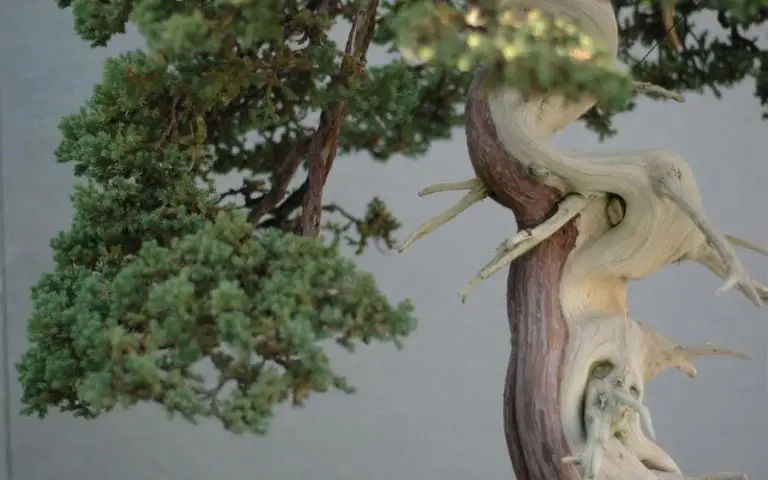A Seasonal Guide to the Juniper Bonsai
The season you take care of a bonsai tree in, such as the Juniper bonsai, can affect the daily watering and other events. Pruning and repotting especially can change depending on the season you’re in. Each season offers changes for how you treat this bonsai.
And so, we present you with our seasonal guide to the Juniper Bonsai.

Image courtesy of 4.0 International
Bonsai Alchemist’s Seasonal Guide to the Juniper Bonsai
There are several aspects we need to cover so that you are prepared when caring for your Juniper bonsai. We’ll look at each one of these and what you should look at per season.
Placement
Throughout the year you can keep the Juniper Bonsai placed outside. Throughout the seasons the plant needs a large amount of sunlight. This requirement ensures that the bonsai always has enough daylight to continue growing.
Bringing the Juniper indoors during winter may be a good idea, however, we recommend only doing this if you’re unable to protect it from the cold in any other way. Once temperatures drop to below 15 degrees Fahrenheit the tree may start to die without being covered or sheltered from the cold.
While some leaves can turn to brownish color, rest assured that if you’re taking care of the Juniper the foliage will return to normal in spring. The tree is hardy and requires minimal attention throughout the year to survive.
Fertilizing
While we often want to fertilize our plants without attention to the guide, the Juniper bonsai can suffer greatly from having too many nutrients. A half-strength liquid fertilizer is great to use. This specific option should see use once a month during the spring and fall.
As the plant goes almost dormant in the winter, it won’t benefit from having any extra nutrients. During the summer you may want to fertilize the tree, however, this as well can be wasteful and detrimental to the bonsai’s growth.
Another important note is that a Juniper bonsai shouldn’t receive fertilizer immediately after repotting.
Watering
Watering the plant is a routine maintained all year round. Even in winter, the Juniper should receive some watering. However, overwatering the Juniper bonsai is a quick way to harm it. The roots for this tree are unfond of soil wetness.
A recommended method for watering in the cooler months is to mist the plant with a small amount of water. This prevents the water from seeping into the soil and roots before the mist evaporates.
Pruning
The best seasons for pruning are spring and summer. These seasons ensure that any pruned areas are quick to heal and begin growing again.
New shoots should be cut once they reach an inch or more in length. His method can begin in spring and is suitable till just before the end of summer.

Image courtesy of ShareAlike 4.0 International
Repotting
While you can change the pot of the Juniper at any point during the year, we recommend doing it during the warmer seasons. This warmth will ensure the tree continues to grow as fast as possible after it’s in a new pot.
Repot the Juniper bonsai every two years. The soil used should be dry, and as such repotting could not occur during the rainy seasons as it can quickly turn into a heavy downpour.
As you repot the bonsai, you should prune its roots to ensure it grows well.
Pests and Diseases
A well cared for and well-placed Juniper bonsai is rather resistant to pests. The tree should, however, get checked regularly in the winter for any pests. Additionally, in winter the Juniper should receive enough light.
The plant itself is extremely vulnerable to pests such as spider mites, Juniper aphids, Juniper scales, and Juniper needle miners. These insects can quickly swarm the plant, even during the coldest of months.
To handle a pest infestation, insecticides and miticides are often quick and efficient solutions. However, you should still investigate why there may be a flood of pests on your tree.
During the winter, fungal rust diseases can quickly have their galls produce tendrils filled with spores that infect neighboring plants. This normally happens after rain however, can be easily avoided.
Once you see orange spots on a leaf, your bonsai has likely contracted fungal rust disease. Unfortunately, once infected it is unlikely that the Juniper can return to normal and be cured.

Image courtesy of 4.0 International
Take Care
While the Juniper bonsai requires year-round attention, it suffers mostly in the winter. With all the pests and diseases that occur during the colder months, you’ll need to take extra care to protect your tree. Remember to keep the plant outdoors and in the sun and your bonsai will continue to grow, no matter the season.







